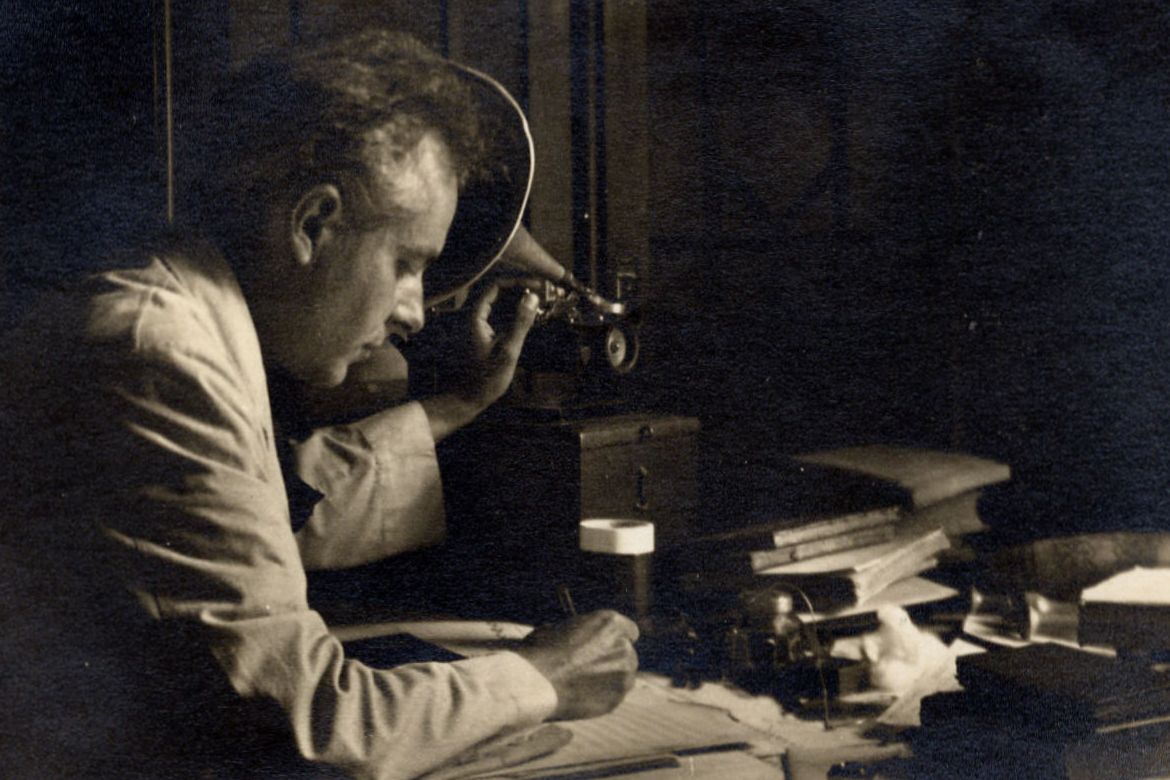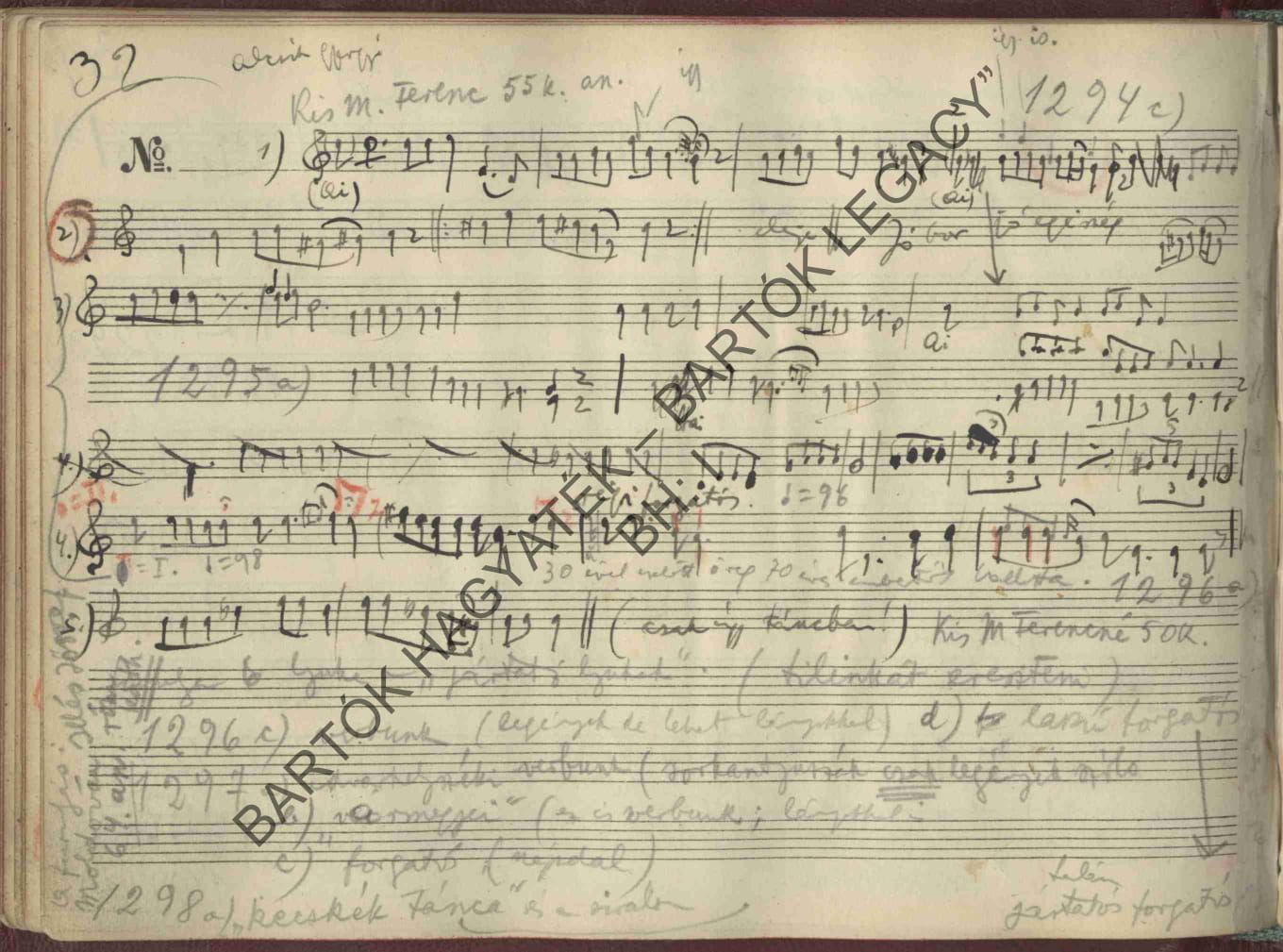 About a third of Béla Bartók’s compositions are folk music arrangements. Bartók chose the material for arrangement predominantly from his own collection made up of about ten thousand folk melodies of different nationalities. Thanks to the so-called Lampert-Catalog, a source catalog of the folk melodies used by Bartók in his works, we now know precisely which are these melodies.[1] The new database of the Budapest Bartók Archives makes available – to the extent possible – the complete source material of these folk melodies. Thus, besides the phonograph recordings of inestimable value that were published earlier, several manuscript transcriptions of the melodies have also become available for study.
About a third of Béla Bartók’s compositions are folk music arrangements. Bartók chose the material for arrangement predominantly from his own collection made up of about ten thousand folk melodies of different nationalities. Thanks to the so-called Lampert-Catalog, a source catalog of the folk melodies used by Bartók in his works, we now know precisely which are these melodies.[1] The new database of the Budapest Bartók Archives makes available – to the extent possible – the complete source material of these folk melodies. Thus, besides the phonograph recordings of inestimable value that were published earlier, several manuscript transcriptions of the melodies have also become available for study.
How did Bartók transcribe the melody during the collecting trip? What remarks did he attach to it? Or, how did he refine his early transcriptions over and over, at times after several decades, in order to fix as accurately as possible the “snapshot” of a given performance of the folk melody, by nature in continual transformation? Associate editor of the database, Viola Biró, research fellow of the Institute for Musicology of the RCH informs about this new project.
 Bartók on folk music collecting trip, Zobordarázs (now: Dražovce, Slovakia), 1907. Source: Bartók Archives, Budapest
Bartók on folk music collecting trip, Zobordarázs (now: Dražovce, Slovakia), 1907. Source: Bartók Archives, Budapest
Throughout his career Bartók was engaged in creating folk music arrangements. He made his first arrangement of a folk song, based on a melody heard from Lidi Dósa, a servant from Transylvania in 1904 (Székely Folksong, BB 34) – the compositional reflection of his first encounter with folk music – at the same time when he was working on his Rhapsody for piano that he signified as his first mature work by marking it as op. 1. The experiences of his important Transylvanian collecting trip in 1907 exerted decisive influence on his style change around 1908 and the formation of his highly personal, avant-garde compositional style. A large number of folk music arrangements – among others, his pedagogical series based on Hungarian and Slovak folk songs, For Children, or the three Romanian piano-series of 1915 intended originally probably as the continuation of the latter, the Romanian Folk Dances, the Romanian Christmas Songs and the Sonatina – as well as original works “impregnated with the spirit” of folk music bear witness to this influence. Folk music arrangements also follow his later changes in style. In his Improvisations on Hungarian Peasant Songs, – an arrangement-series written in the proximity of The Miraculous Mandarin or the Three Studies, his boldest and most modern compositions of 1918–20, – he „reached the extreme limit in adding most daring accompaniments to simple folk tunes”.[2] After 1926, an outstanding milestone in Bartók’s oeuvre, folk music arrangements – such as the two Violin Rhapsodies (1928–9), the Twenty Hungarian Folksongs for voice and piano (1929) or the Hungarian Folksongs for mixed voices (1930) – written mostly on commission or for specific performers, reflecting also on contemporary trends (primarily on Kodály’s works), are masterpieces representative of his mature classical style. We can find folksong arrangements also among his last compositions.
As Bartók stated, “to handle folk melodies is one of the most difficult tasks; equally difficult if not more so than to write a major original composition”.[3] Writing folk music arrangements was an excellent training for the young composers. Peasant music, completely unknown in urban culture at that time – collected by the composers themselves on journeys to faraway, exotic lands, – turned out to be the best starting point for Bartók and Kodály in creating a “new Hungarian Art Music”, an up-to-date but peculiarly Hungarian musical language that broke with the overexploited harmonic system and exuberantly sentimental style of late Romanticism. Arranging folk melodies was the first step in this direction. Yet as Bartók emphasizes, “it is of the greatest importance that the musical qualities of the setting should be derived from the musical qualities of the melody, from such characteristics as are contained in it openly or covertly, so that melody and all additions create the impression of complete unity”.[4]
 Bartók–Kodály: Hungarian Folksongs for voice and piano (Budapest: Rozsnyai, 1906)
Bartók–Kodály: Hungarian Folksongs for voice and piano (Budapest: Rozsnyai, 1906)
Another object of Bartók’s and Kodály’s folk music arrangements was to acquaint the widest audience with the unique folkloristic treasure collected by them. Typically Bartók chose melodies for arrangement that he considered particularly valuable, or in which he was especially interested from a creative point of view. Therefore it is not surprising, for example, that old style melodies of Hungarian folk music, much appreciated by Bartók, are represented in great proportion among his arrangements.[5] Bartók transferred the chosen melody into art music ambience, usually keeping it as close to the original peasant performance as possible. At times, it happens however, that for the sake of certain compositional ideas he alters the original folk melody to some extent: uses it with different words, modifies the melody line here and there in order to get a stricter structure more suitable for compositional treatment, eventually he shapes the “ideal” form of the melody by compiling it from different verses or close variants of the same melody. But even in these cases his modifications remind us of the variability of the folk music itself.
 Bartók while transcribing from the phonograph, ca 1918. Source: Bartók Archives, Budapest
Bartók while transcribing from the phonograph, ca 1918. Source: Bartók Archives, Budapest
The Folk Music in Bartók’s Compositions database provides us insight into the deeper layers of the genesis of these works: it unfolds the folkloristic background that captured Bartók’s creative imagination. The phonograph recordings and the different transcriptions of the folk melodies offer a very close and nuanced picture about the source melodies. By the study of the folkloristic sources and by confronting them with the composition we can get a closer look into the workshop of the composer: we can observe Bartók’s attitude towards his source melody, when it follows exactly the folk music transcription, and in which case, for what reason handles it more freely – that is, how a folk melody turns into a composition.
The database publishes all written and audio sources of the folk melodies considered as the most probable source melodies – in our present knowledge – used in Bartók’s works. In this manner such manuscript sources become freely available for study – in good quality facsimiles, as possible – that until now were accessible only for a small group of researchers.
 Bartók’s field book no. M.VI (in the upper stave the source melody of Fifteen Hungarian Peasant Songs no. 3). Source: BH: I/111, Gábor Vásárhelyi’s collection
Bartók’s field book no. M.VI (in the upper stave the source melody of Fifteen Hungarian Peasant Songs no. 3). Source: BH: I/111, Gábor Vásárhelyi’s collection
Especially valuable in this respect are the primary sources of the folk music collecting trips, the so-called field books, in which Bartók notated the melodies on the spot; similarly of inestimable value are the “historical” sound recordings of the melodies, the “snapshots” of the folk melodies recorded on phonograph cylinders during the collecting trip. Afterwards fair copies of each transcription were made based on the mostly sketchy first notations; these transcriptions, written each on a separate sheet of paper – called master sheets – served for later organization and analysis of the melodies. The transcriptions elaborated on different levels are true treasuries of folkloristic information for those interested in philological matters. If a folk melody has unusually numerous sources this, in most cases, alludes to the fact that Bartók was keenly interested in that particular melody also from the scientific point of view, and at times even used them as illustrations in his writings and lectures on folk music. A list of abbreviations provides information about the different collections of manuscript sources, sound recordings and publications that occur in the database.
 Master sheet from the Bartók System, AI 524c (source melody of the first line of Fifteen Hungarian Peasant Songs no. 3). Source: Bartók System
Master sheet from the Bartók System, AI 524c (source melody of the first line of Fifteen Hungarian Peasant Songs no. 3). Source: Bartók System
The content of the database is being uploaded in line with the publication of the Béla Bartók Complete Critical Edition (München, Budapest: G. Henle Verlag, Editio Musica Budapest, 2016–), thus currently only data of those arrangements are available here which already have been published in the Complete Edition and which contain (also) folk music arrangements (Vol. 9: Choral Works; Vol. 37: For Children; Col. 38: Piano Works, 1914–1920). The composition is represented in the database by a relevant excerpt from its score in the Complete Edition. Furthermore, a representative modern recording, and – if available – Bartók’s own interpretation of the work is provided as well.
The database is based essentially on Vera Lampert’s Folk Music in Bartók’s Compositions: A Source Catalog (Budapest: Helikon, 2008), but it is an enlarged, interactive version of it. The scope of the folk music sources used in the Lampert-catalog was slightly broadened with a few other collections. We republish, however, Vera Lampert’s significant introductory study, with some necessary modifications. We take over also the map containing the provenances of all folk melodies used by Bartók, but adjusting it to the digital edition, in interactive form. The concept of the „mostly analytic” part of the database, the comparison of selected original transcriptions of the folk melody with the version(s) used in the arrangement, was originally also an idea of the editor of the volume, though it hadn’t been published earlier; considering the newly included source material, this concept had to be reconsidered and published in a revised form.
The digital edition of the Folk Music in Bartók’s Compositions was initiated by Márton Kerékfy (Institute for Musicology of RCH), editor of the Bartók Complete Edition. The complete structure of the database mirrors his conception. Its realization is the result of the collaboration of system administrator Natália Zagyva and several members of the Bartók Archives staff (Márton Kerékfy, Viola Biró, Yusuke Nakahara, Virág Büky).
Viola Biró
Research fellow of the Bartók Archives of the Institute for Musicology
The Hungarian version of this article is available here.
[1] Vera Lampert, Bartók népdalfeldolgozásainak forrásjegyzéke (Budapest: Zeneműkiadó, 1980); Lampert, “Quellenkatalog der Volksliedbearbeitungen von Bartók,” in Documenta Bartókiana 6., ed. László Somfai (Budapest: Akadémiai Kiadó, 1981), 15–149.; Lampert, Népzene Bartók műveiben: A feldolgozott dallamok forrásjegyzéke, with CD-supplement containing the original phonograph records of the melodies (Budapest: Helikon, 2005); Lampert, Folk Music in Bartók’s Compositions: A Source Catalog, with CD-supplement (Budapest: Helikon, 2008).
[2] Béla Bartók, “Harvard-lectures,” in Béla Bartók, Essays, ed. Benjamin Suchoff (London: Faber & Faber, 1976), 375.
[3] Bartók, “On the Significance of Folk Music,” in Bartók, Essays, 345.
[4] Idem., 342.
[5] For more details on this, see Vera Lampert, “Bartók’s Choice of Theme for Folksong Arrangement: Some Lessons of the Folk-Music Sources of Bartók’s Works,” Studia musicologica 24/3–4 (1982): 401–409.

